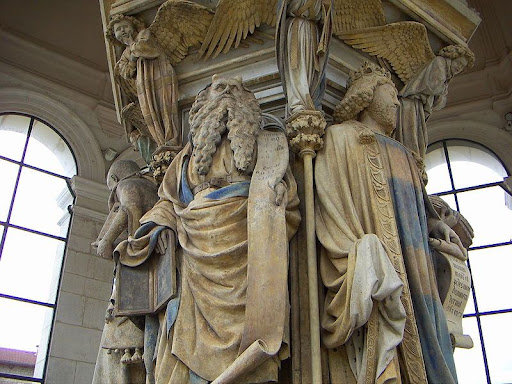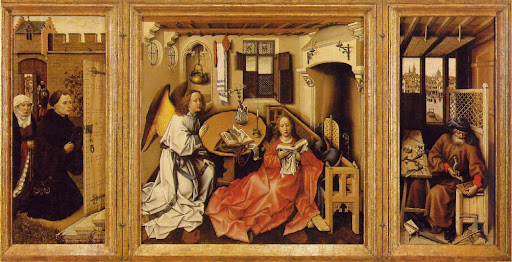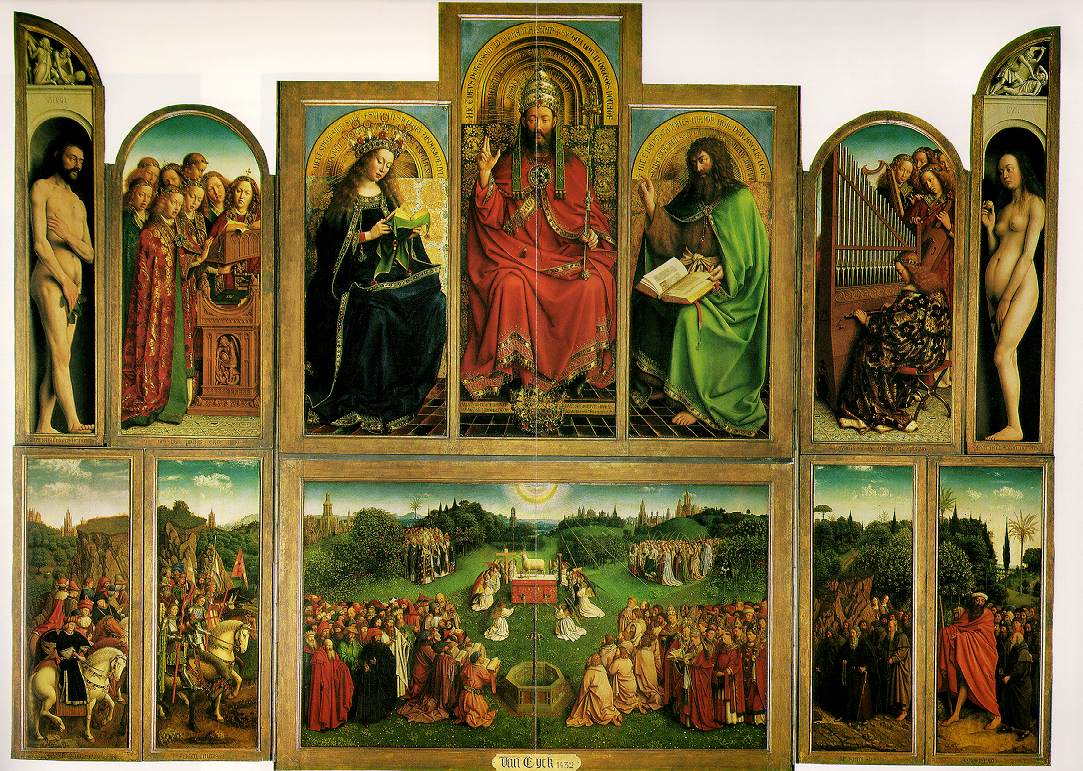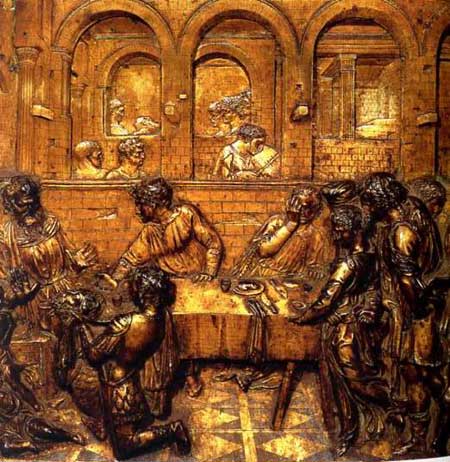Cards In This Set
| Front | Back |
 ? |
Cimabue of Florence, "Madonna Enthroned," 1280-90. Tempera on Panel.-Church of Santa Trinita in Florence (Byzantine-style icon)-Linear gold elements enhance dignity-Hebrew prophets foundation of throne-Blue robe = Heaven-Severe design and solemn expression-Gesture toward Christ-Perspective not completely understood (2D vs. 3D)
|
 ? |
Giotto di Bondone, "Madonna Enthroned," 1310. Tempera on panel.-Church of All Saints in Florence-Giotto possibly student of Cimabue-Blue robe = Heaven-Figures modeled in light to create solid, sculptural forms-Space suggested by angels kneeling before throne and overlapping of angels standing on a level surface-Throne = contemporary Italian architecture-Stone textures suggest familiarity with ancient murals in Medeival Rome
|
 ? |
Giotto di Bondone, Interior of Arena (Scrovegni) Chapel, Padua. Fresco.-Giotto from Florence but so famous invited to Padua-Commissioned by Scrovegni family (NOT Church), indicative of the rise of the Middle Class through new industries such as banking-Dedicated to "Our Lady of Charity"-One-room hall covered with a barrel vault-Blue field with big stars symbolic of heaven-walls divided into 3 registers (horizontal rows)-narrative scenes represent the lives of the Virgin and Christ (top register depicts early life of Mary and her parents, center register focuses on stories of christ's life and miracles, and lowest register depicts Passion, Death, and Resurrection)-Giotto includes the figure of the donor, Enrico Scrovengi, offering his chapel to the Virgin and angels
|
 ? |
Giotto di Bondone, "Christ Entering Jerusalem," Arena (Scrovegni) Chapel, Padua. 1305-06. Fresco.-Palm Sunday; Christs arrives on a humble mount-entire scene in foreground, close to viewer-spare setting, large simple forms-Jesus in isolation and dignity, bridges the gap between the two groups-solemn tone
|
,%20Cappella%20Scrovegni%20a%20Padova,%20Life%20of%20Christ,%20Lamentation%20(fresco).jpg) ? |
Giotto di Bondone, "The Lamentation," Arena (Scrovegni) Chapel, Padua. 1305. Fresco.-Conventions - symbols used overly much (dead tree, blue robes)-Lamentation = Moment of last farewell between Jesus and his mother and friends-low center of gravity, hunched figures, cool colors, bare sky convey somber/tragic mood-frozen grief contrasts w/fluttering of angels-descending slope of hill acts as unifying element that directs attention toward heads of Christ and the Virgin-bare tree = Tree of Knowledge to be restored to life through Christ's sacrificial death
|
 ? |
Claus Sluter, "The Well of Moses." Chartreuse de Chapmol, France. 1395-1406. Stone, 6'.-example of International Gothic style-located in Carthusian monastery, Chartreuse de Chapmol, sponsored by Philip the Bold (French royal family)-hexagonal well surrounded by Hebrew prophets-Biblical figures share our earthly environment-deeply influenced by classical sculpture-was once topped by life-size Cavalry scene with Christ on the Cross (New Testament above Old Testament)-Moses has long flowing beard and horns (mistranslation of Hebrew word for "ray")-each prophet carries a scroll predicting the death of christ-King David wears crown/robe of monarchy-naturalistic-was once painted
|
 ? |
Robert Campin, "Merode Triptych." 1425-30. Oil on oak.-Campin was a pioneer of the naturalistic revolution (Rogier van der Weyden part of his workshop)-Very small, could be carried from house to house-Central panel = Annunciation (but Virgin and Gabriel located in bourgeois house) which could represent the patrons' own desire for children or reverence for the Holy Family as a model for their own-boxes of space, detail, 2 kinds of light (diffused that creates shadows, direct through windows)-Campin catered to fellow townsmen, donors shows kneeling outside Virgin's chamber-Coat of Arms indicates patron's family-Tiny figure of a baby holding a cross (Christ) floats toward Mary-Garden door is too narrow for horse, indicating Mary's virginity-Right panel depicts Joseh the carpenter at work (could be Devil's mousetrap = God's plan for salvation, wine press representing the Eucharist-Conventions: flowers associated with Virgin -Smoking candle = weird. Why lit during day? Why extinguished? Arrival of true light (Christ) extinguishes mundane one-pragmatic merchants demanded directly observed renderings of things they could see-Personalized approaches to religion: believers encouraged to visualize the sacred in terms they could understand and to meditate on events from Christ's life in order to incr. their empathy and devotion ("Modern Devotion")-Call to see the physical world as a mirror of divine truths
|
 ? |
(CLOSED) Hubert and Jan van Eyck, "Ghent Altarpiece." Church of St. Bavo, Ghent, Belgium. 1432. Oil on panel.-most famous of early Flemish paintings-installed in cathedral of St. John in Ghent-inscription on frame identified Jan Van Eyck as the artist and alluded to the collaboration of older brother Hubert-welathy donor and his wife appear on the lower tier with John he Baptist and John the Evangelist, patrons of the cathedral, painted in grisaille (monochrome, grayish color of statues)-four combined into one scene with foreshortened ceiling, shadows on the floor as if cast by frame-upper story = prophets and sibyls and gothic script-wings stayed closed except on Sundays and feast days
|
 ? |
(OPEN) Hubert and Jan van Eyck, "Ghent Altarpiece." Church of St. Bavo, Ghent, Belgium. 1432. Oil on panel.-bottom tier = image of altar, sacrificial Lamb representing christ-angels, apostles, popes, theologians, virgin martyrs, hermits, pilgrims, knights, and judges-Court of Heaven with Lord in bright red robe reigns above, flanked by mary and John the Baptist-Adam and Eve rendered as nudes (special attention paid to anatomy and shadows)-grisaille images of Abel and Cain-tone and function = majestic, elucidates liturgy happening in fromt of it bc the subject is literally mass-building up layers leads to saturated hues-importance of the Church itself as an institution and as a pathway to salvation
|
 ? |
Jan Van Eyck, "The Arnolfini Portrait." 1434. Oil on panel.-most studied and still mysterious work-Giovanni Arnolfini, Italian merchant-For years scholars believed the woman was his wife but this is now doubtful bc marriage took place later-fifteenth century house-man is taking solemn oath, seemingly isolated in room-mirror has reflection of 2 men, one of them possibly Jan who acted as a witness (also indicated by signature)-could represent legal and financial contract of wedding or engagement (second man could be bride's father)-gesture to lift heavy gown = wish for children-bed = consummation-OR commemoration of wife who died giving birth-St. Margaret - women prayed to her for safe delivery-details could be accuracy OR religiously symbolic -shoes off = standing on holy ground-little dog beloved pet or emblem of fidelity-candle burning in broad daylight-pieces of fruit = wealth or temptation of Eve-tiny images of Resurrection and Passion in small medallions around mirror
|
 ? |
Brunelleschi, Pazzi Chapel, 1430-1460, Florence-"Conceived as a whole" (Exterior matches interior; opposed to Gothic churches)-Architectural necessities of the building become decorative ornamentations (rather than being covered in sculpture like Gothic)-Mathematical proportions create "harmony"-Contributed to church by extremely rich family (Pazzi); reflection of piety and wealth-Seperate building for the monks-Bringing together Pagan (antiquity) with Christian (Idea of blending still "comfortable" in this century)-Humanism leads to new approaches in architecture (3 trinity:4:7 days of creation/deadly sins proportion)-Justify use of classical past through Christian association-Perfectly symmetrical
|
 ? |
Donatello, St. George, 1417 or San Michele (Bargello), Florence-Gothic structure but Classical sculpture -Guild church (armorers)-St. George = patron saint of armorers b/c warrior wearing armor; most famous feat = killing dragon-Looking out of niche; furrowing of brow; hint of stepping out of niche (emphasis on individual as rational, thinking being)-Hair technique from ancient sculpture-Alludes to human body under drapery/armor-Shape of shield = Shape of entire sculpture-Watchfulness/preparedness for danger-Below= slaying of dragon (schiatto, meaning shallow relief)
|
 ? |
Donatello, Feast of Herod, Siena Cathedral, 1425, gilt bronze-John the Baptist's martyrdom-Salome, the step-daughter of King Herod, requested the head of the saint as a reward for performing the Dance of the Seven Veils-Head of John the Baptist being presented to King Herod-Brunelleschi's architecture evident in arches-Perspective gives sense of real space-Tableau divided into 2 parts; middle = "dramatically charged space"-drama, tension, emotion shown through position of the body, not just facial expression-Many stages of narrative located on one panel -Frame becomes a window through which is seen a segment of deepening space-uses perspective to organize the action as a continuous narrative, unfolding through space as well as time
|
 ? |
Lorenzo Ghiberti, east doors, baptistery, Florence Cathedral, Florence, Italy, 1425-1452. Gilded bronze.-Commissioned by Guild of Wool Merchants-Modeled off of Donatello (create realistic illusion of space)-Called "Gates of Paradise" by Michelangelo-Emphasis on structure/division-10 stories of Old Testament, portraits of famous people, prophets-Clarity, symmetry, organization, "mathematical harmony"-Panels framed with figures of prophets in niches, portrait heads in roundels, and foliate decorations-Specific panel: Isaac and his sons; younger son blessed instead of older son; allegory for New Testament superceding Old Testament-More than one scene in one panel (the same person depicted multiple times = vestige of Medeival Art
|
 ? |
Donatello, David, ca. 1420s-60s, cast in bronze-Modeled after Doryphorus (Contrapasto position)-Commissioned by the Medicis-First freestanding male nude (lifesize) since antiquity-Uncomfortable b/c of nudity, almost idol (thou shalt not worship false idols)-David = Emblem of city of Florence-Young Christian warrior reminds citizens of responsibility to defend the faith/Florence, especially against the Duchy of Milan -Defeated Goliath has the emblem of Milan on it-New relation to antiquity (inspired by but does not imitate)-Adolescent rather than grown man (body is not idealistic; much more realistic)-Doesn't really fit with Bible; still holding stone that defeated Goliath; expression seems impassive considering terror-Difficult to cast bronze this large (hole = imperfection that shows how hard this was to do)
|



